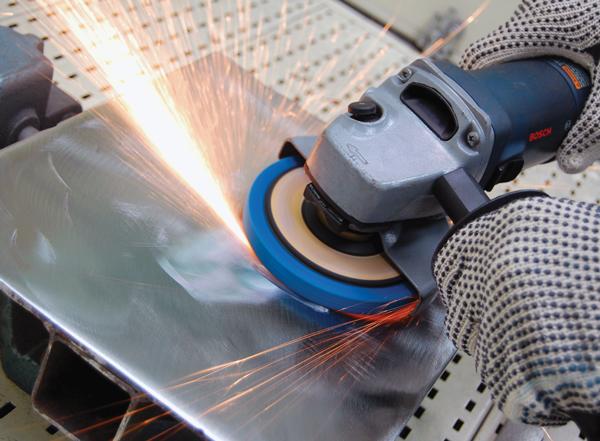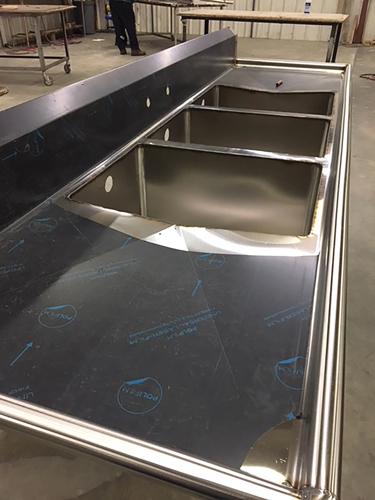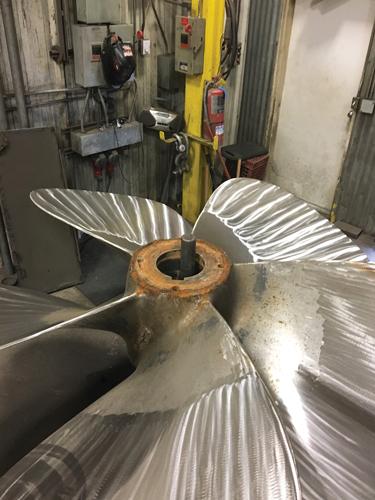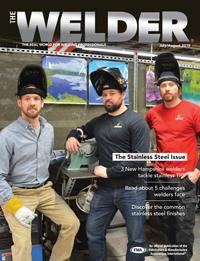Product Manager
- FMA
- The Fabricator
- FABTECH
- Canadian Metalworking
Categories
- Additive Manufacturing
- Aluminum Welding
- Arc Welding
- Assembly and Joining
- Automation and Robotics
- Bending and Forming
- Consumables
- Cutting and Weld Prep
- Electric Vehicles
- En Español
- Finishing
- Hydroforming
- Laser Cutting
- Laser Welding
- Machining
- Manufacturing Software
- Materials Handling
- Metals/Materials
- Oxyfuel Cutting
- Plasma Cutting
- Power Tools
- Punching and Other Holemaking
- Roll Forming
- Safety
- Sawing
- Shearing
- Shop Management
- Testing and Measuring
- Tube and Pipe Fabrication
- Tube and Pipe Production
- Waterjet Cutting
Industry Directory
Webcasts
Podcasts
FAB 40
Advertise
Subscribe
Account Login
Search
Finishing stainless steel
An overview of common finishes and technological advancements
- By Michael Radaelli
- Updated January 19, 2024
- July 27, 2019
- Article
- Finishing

Stainless steel has several common finishes. It’s important to know what these common finishes are and why they are important. Recent innovations in abrasives technology can reduce process steps to deliver the desired finish, including that sought-after surface shine.
Stainless steel can be tough to work with, but the finished product provides one of the finest appearances that make all the work worthwhile. It is widely understood that a finer grit in a sanding sequence removes the previous scratch pattern and improves the finish, but there is a lot to be aware of regarding the overall steps required when using the many grit sequences to achieve the desired finish.
Stainless steel has several common finishes. It’s important to know what these common finishes are and why they are important. Recent innovations in abrasives technology can reduce process steps to deliver the desired finish, including that sought-after surface shine.
Common Stainless Steel Finishes
The Specialty Steel Industry of North America (SSINA) depicts the industry standards and where the different finish numbers are utilized on products.
A No. 1 finish is produced by rolling stainless steel that has been heated before rolling (hot rolling). Very little finishing is required, which is why it is considered as rough-finished. Common products with a No. 1 finish are air heaters, annealing boxes, boiler baffles, various furnace parts, and gas turbines, to name a few.
The No. 2B finish, a bright, cold-rolled finish, resembles a cloudy mirror and does not require finishing steps. Parts with a No. 2B finish include common bakeware, chemical plant equipment, flatware, paper mill equipment, and plumbing fixtures.
Also within the No. 2 category is a No. 2D finish. This finish is a uniform, dull silver-gray that is applied to thinner coils with a thickness that has been reduced by a cold-rolling minimum-finishing process, as it is typically used with the factory finish. Pickling or descaling is necessary after heat treatment to remove the chromium. Pickling can be the final production step of this finish. A No. 2D finish is preferred as a substrate when a painted finish is desired because it provides excellent paint adherence.
A No. 3 finish is characterized by short, relatively coarse, parallel polishing lines. It is obtained by either mechanically polishing with gradually finer abrasives or by passing the coil through special rolls, which press a pattern into the surface, simulating the appearance of mechanical abrasion. It is a moderately reflective finish.
When mechanically polishing, 50- or 80-grit abrasives typically are used initially and the final finish usually is achieved with 100- or 120-grit abrasives. The surface roughness typically has a roughness average (Ra) of 40 microinches or less. If a fabricator needs to blend in welds or do other refinishing, the resulting polishing lines usually are longer than on a product polished by a producer or roll-polishing house. A No. 3 finish is most seen in brewery equipment, food processing equipment, kitchen equipment, and scientific apparatuses.
A No. 4 finish is the most common and is used on appliances and in the food industry. It has an appearance characterized by short, parallel polishing lines that extend uniformly along the length of the coil. It is obtained by mechanically polishing a No. 3 finish with gradually finer abrasives. Depending on the requirements of the application, the final finish can be anywhere between 120- and 320-grit. Higher grit numbers produce finer polishing lines and more reflective finishes.
The surface roughness is typically Ra 25 µin. or less. This finish is widely used for restaurant and kitchen equipment, storefronts, and food processing and dairy equipment. As with the No. 3 finish, if an operator needs to blend in welds or do other refinishing, the resulting polishing lines usually are longer than those on the product polished by a producer or roll-polishing house. Other areas where a No. 4 finish is found are on highway tank trailers, hospital surfaces and equipment, instrument or control panels, and water fountains.

A No. 3 finish is characterized by short, relatively coarse, parallel polishing lines. It is obtained by either mechanically polishing with gradually finer abrasives or by passing the coil through special rolls, which press a pattern into the surface, simulating the appearance of mechanical abrasion. It is a moderately reflective finish.
The No. 7 finish has a high degree of reflectivity and a mirror-like appearance. A No. 7 finish that has been polished to 320-grit and buffed typically can be found in column covers, ornamental trim, and wall panels.
Advancements in Abrasives
The abrasives used to achieve those surface finishes have undergone significant advancements that can help fabricators produce more pieces safely, quickly, and cost-effectively. New minerals, stronger fibers, and smear-resistant resin systems help to optimize finishing processes.
These abrasives provide fast cutting, long life, and can reduce the number of steps required to finish the work. For example, a flap disc with ceramic grain microfractures at a slow rate, extending its life and providing a consistent finish.
Also, technology similar to aggregate abrasives has grains that are bonded together to cut faster and provide a better finish. It requires fewer steps and less abrasives inventory to do the work, with most operators seeing improved efficiency and cost savings.
A Challenging Stainless Steel Part
A fabricator was challenged to finish corners and the radius of a stainless steel part. To blend the difficult-to-reach weld and molded areas, it had a five-step process that required grinding wheels, square pads in several grits, and a unified wheel.
To start, an operator used the grinding wheel to impart deep scratches on these stainless steel parts. Grinding wheels typically are hard with less forgiveness, putting the operator at a disadvantage at the start. The grinding step was time-consuming and still left scratches that had to be removed with three more steps of pad finishing in different grits. This step was followed by using a unified wheel to achieve the desired surface finish.
By changing the grinding wheel to a ceramic-based flap wheel, the operator was able to produce a finish in step one. Keeping the same grit sequence as in the second step, the operator exchanged the square pad for a flap wheel, which improved the time and finish.
Removing the 80-grit square pad and replacing it with a nonwoven depressed-center wheel with agglomerated grain, followed by 220-grit nonwoven depressed-center wheel, allowed the operator to produce the required shine and overall finish and eliminated the last step in the original process (using a unified wheel to close out the steps).
Due to the improvement in flap wheels and nonwoven technology, the number of steps was reduced from five to four, which improved finishing time by 40 percent, saving on labor and product cost.
About the Author
Michael Radaelli
508-795-5000
About the Publication
Related Companies
subscribe now

The Welder, formerly known as Practical Welding Today, is a showcase of the real people who make the products we use and work with every day. This magazine has served the welding community in North America well for more than 20 years.
start your free subscription- Stay connected from anywhere

Easily access valuable industry resources now with full access to the digital edition of The Fabricator.

Easily access valuable industry resources now with full access to the digital edition of The Welder.

Easily access valuable industry resources now with full access to the digital edition of The Tube and Pipe Journal.
- Podcasting
- Podcast:
- The Fabricator Podcast
- Published:
- 04/16/2024
- Running Time:
- 63:29
In this episode of The Fabricator Podcast, Caleb Chamberlain, co-founder and CEO of OSH Cut, discusses his company’s...
- Trending Articles
Sheffield Forgemasters makes global leap in welding technology

ESAB unveils Texas facility renovation

Engine-driven welding machines include integrated air compressors

The impact of sine and square waves in aluminum AC welding, Part I

How welders can stay safe during grinding

- Industry Events
16th Annual Safety Conference
- April 30 - May 1, 2024
- Elgin,
Pipe and Tube Conference
- May 21 - 22, 2024
- Omaha, NE
World-Class Roll Forming Workshop
- June 5 - 6, 2024
- Louisville, KY
Advanced Laser Application Workshop
- June 25 - 27, 2024
- Novi, MI



























